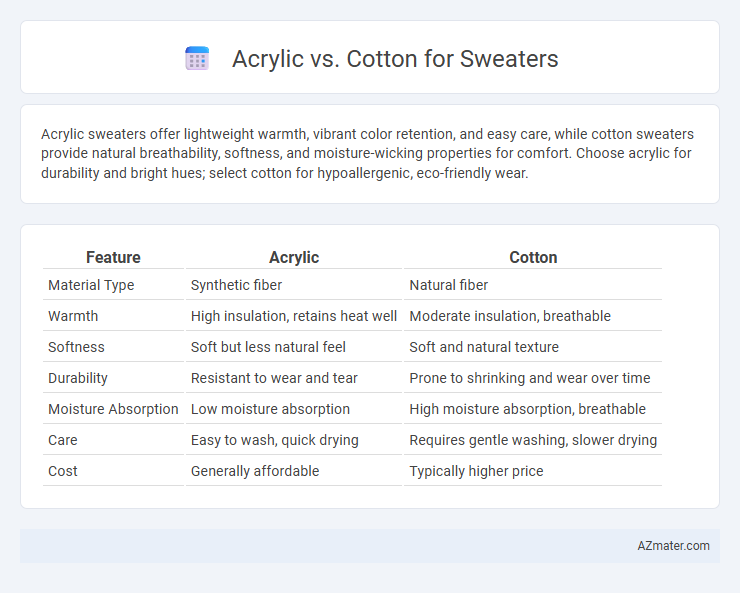Acrylic sweaters offer lightweight warmth, vibrant color retention, and easy care, while cotton sweaters provide natural breathability, softness, and moisture-wicking properties for comfort. Choose acrylic for durability and bright hues; select cotton for hypoallergenic, eco-friendly wear.
Table of Comparison
| Feature | Acrylic | Cotton |
|---|---|---|
| Material Type | Synthetic fiber | Natural fiber |
| Warmth | High insulation, retains heat well | Moderate insulation, breathable |
| Softness | Soft but less natural feel | Soft and natural texture |
| Durability | Resistant to wear and tear | Prone to shrinking and wear over time |
| Moisture Absorption | Low moisture absorption | High moisture absorption, breathable |
| Care | Easy to wash, quick drying | Requires gentle washing, slower drying |
| Cost | Generally affordable | Typically higher price |
Overview: Acrylic vs Cotton Sweaters
Acrylic sweaters offer lightweight warmth, excellent color retention, and affordability, making them a popular choice for budget-friendly, machine-washable knitwear. Cotton sweaters provide natural breathability, softness, and moisture absorption, ideal for those seeking breathable, hypoallergenic fabrics with a comfortable fit. Acrylic fibers tend to resist wrinkles and shrinkage, whereas cotton requires more delicate care to maintain shape and texture over time.
Fiber Composition and Source
Acrylic sweaters are made from synthetic fibers derived from polymer compounds, primarily acrylonitrile, produced through chemical processes in factories. Cotton sweaters consist of natural fibers harvested from the cotton plant, offering breathability and moisture absorption due to their cellulose-based structure. The synthetic nature of acrylic provides durability and wrinkle resistance, while cotton's plant-based origin ensures softness and biodegradability.
Warmth and Insulation Properties
Acrylic sweaters provide excellent warmth due to their synthetic fibers that trap heat efficiently, making them ideal for cold climates. Cotton sweaters, however, offer moderate insulation but lack the heat-retention ability of acrylic, often resulting in less warmth during chilly weather. Acrylic's moisture-wicking properties enhance insulation by keeping skin dry, whereas cotton tends to absorb moisture, which can reduce its thermal effectiveness.
Comfort and Skin Feel
Acrylic sweaters offer a lightweight, soft texture that mimics wool but can sometimes cause static and feel less breathable compared to cotton. Cotton sweaters provide superior breathability and moisture absorption, enhancing comfort for sensitive skin and reducing irritation. Choosing cotton ensures a natural, soft feel ideal for all-day wear, while acrylic serves as a durable, hypoallergenic alternative with a smoother finish.
Breathability and Moisture Management
Cotton sweaters excel in breathability due to their natural fibers, allowing air to circulate and keeping the wearer cool and comfortable. Acrylic, being a synthetic material, offers less breathability but provides better moisture-wicking properties, drawing sweat away from the skin to dry quickly. For optimal moisture management during active wear, acrylic blends outperform pure cotton by maintaining warmth while reducing dampness.
Durability and Longevity
Acrylic sweaters offer superior durability due to their resistance to moths, mildew, and abrasion, making them less prone to wear and tear compared to cotton. Cotton sweaters, while breathable and comfortable, tend to weaken and degrade faster with repeated washing and exposure to sunlight. Choosing acrylic ensures longer-lasting garments with better shape retention and colorfastness over time.
Maintenance and Care Requirements
Acrylic sweaters demand low maintenance with easy machine washing and quick drying, resisting shrinking and wrinkles. Cotton sweaters require gentler care, often needing hand washing or delicate cycles to prevent shrinking and fabric wear. Proper storage is essential for both, but cotton's natural fibers may attract more pilling and require regular de-pilling to maintain appearance.
Environmental Impact and Sustainability
Acrylic sweaters are made from synthetic fibers derived from petroleum, contributing to microplastic pollution and non-biodegradability, which harms ecosystems and increases landfill waste. Cotton sweaters, especially organic cotton, offer a more sustainable option due to their natural origin and biodegradability, but conventional cotton farming requires significant water, pesticide use, and land resources. Choosing sweaters made from organic or sustainably farmed cotton with eco-friendly dyeing processes minimizes environmental impact and supports sustainable garment production.
Cost and Value Comparison
Acrylic sweaters generally cost less than cotton ones due to lower production expenses and synthetic fiber material. Cotton sweaters offer better breathability and durability, often providing higher long-term value despite a higher initial price. Choosing between acrylic and cotton involves balancing budget constraints with preferences for comfort and garment lifespan.
Best Uses and Style Considerations
Acrylic sweaters excel in affordability, vibrant color retention, and moisture resistance, making them ideal for casual wear and layering during transitional seasons. Cotton sweaters offer superior breathability and natural softness, perfect for warm-weather comfort and classic, versatile styles that suit both casual and semi-formal occasions. Choosing between acrylic and cotton depends on desired durability, texture preference, and climate suitability for optimal style and function.

Infographic: Acrylic vs Cotton for Sweater
 azmater.com
azmater.com